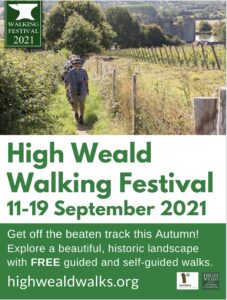Message from Doug Edworthy, Tree Warden, Brightling and Dallington parishes:
“Forestry England have let me know of dates when there will be shooting on their land in Purchase Wood, Deer Park.
It’s in the North of the wood but best to avoid on those days, especially going off main tracks.
November 6,9,13, 16,20,23, 27,30
December 4,7,11,14, 18, 28,
January 8,11,15
People with nervous dogs, especially, might want to avoid the wood on those dates.”

 Text of enclosed flyer:
Text of enclosed flyer: Bookings are now open for the Wild About Dark Skies Festival
Bookings are now open for the Wild About Dark Skies Festival On a cold and sleety morning four parish councillors (Nicky Holyoake, Jim Gray, Nick Harding and Pauline Ridley) met up at the triangle at the top of The Street to strim the grass and plant a selection of spring bulbs. We will be carrying out more work over the next few months and adding more planting to improve the appearance of the triangle.
On a cold and sleety morning four parish councillors (Nicky Holyoake, Jim Gray, Nick Harding and Pauline Ridley) met up at the triangle at the top of The Street to strim the grass and plant a selection of spring bulbs. We will be carrying out more work over the next few months and adding more planting to improve the appearance of the triangle. Booking is now live for the High Weald Walking Festival. Choose from more than 30 FREE guided walks across the High Weald Area of Outstanding Beauty, running
Booking is now live for the High Weald Walking Festival. Choose from more than 30 FREE guided walks across the High Weald Area of Outstanding Beauty, running